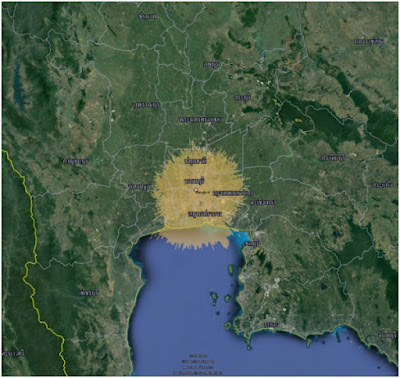NBTC Thailand has started DAB+ radio trial transmission officially since 2018 in these locations below:
1. Bangkok
2. Chiang Mai
3. Pattaya
4. Sriracha
5. Khon Kaen
6. Nakhon Ratchasima
7. Nakhon Si Thammarat
8. Phuket
9. Prachuap Khiri Khan
10. Songkhla (Hat Yai)
Here are the coverage map of DAB+ radio transmission in Bangkok, Thailand (source: NBTC broadcast website)
Based on the coverage map and according to NBTC website (https://broadcast.nbtc.go.th/news/preview.php?news=NjEwNTAwMDAwMDAy&type=NTYwNDAwMDAwMDAx), Bangkok DAB+ radio is tested on Channel 6C (VHF 185.36MHz) with maximum power at 10kW, the antenna height of the DAB+ trial transmission in Bangkok is 185m, and its antenna polarization is vertical. Transmission site is located at Royal Thai Army signal department office.
As I'm a former junior broadcast engineer, despite I'm not from telecommunication engineering background, but I personally understand that it is not easy to launch DAB+ radio, even to replace FM radio with DAB+ radio (digital switchover).
DAB+ technology has its pros and cons actually, the advantage of this radio technology is to ease the FM frequency spectrum congestion by persuading some broadcasters to use DAB+ platform, DAB+ increases the frequency spectrum efficiency.
It is successful in Western Europe countries such as United Kingdom, Ireland and Norway, but moderate successful in Central and East Europe. However, DAB+ has its disadvantages too, but DAB+ is a failure in Singapore and Hong Kong, consumers' habits, budget and marketing are the biggest reason of DAB+ is unsuccessful in some countries.
Although DAB+ helps to improve the frequency spectrum efficiency by reducing usage of frequency band through a frequency carry multiple radio stations (MUX), but DAB+ requires more gap filler transmissions site than conventional FM and AM radio. Example: Songkhla province only needs 1 transmitter from Khao Kho Hong to cover whole province on FM, but the province needs more additional gap filler transmitter site to cover whole province when comes to DAB+.
DAB+ carries higher frequency band than FM. In basic theory, the lower the frequency band, the further of the transmitting distance. Meanwhile, the higher the frequency band, the lesser of the transmitting distance.
Moreover, most of the consumer's radio receivers have no DAB+ band. It is expensive to own DAB+ receiver. In Malaysia, to purchase a DAB+ receiver, the minimum price is RM 600 (approximate THB 4400). Due to growing of 5G technology, DAB+ is facing the challenge from alternative competitor because people can easily access listening to their favorite radio station digitally via high speed internet with 5G technology. Before launching of 5G, 4G/LTE is quite perfect for listening to radio stations via online as they run high speed too (but lesser than 5G). For car radio, most of the vehicles have no DAB+ band, but Apple Car Play/Android Auto, consumers use Apple Car Play/Android Auto to listen to radio stations via online by connecting Internet, even with conventional Bluetooth/AUX connectivity, therefore smartphone also "kills" DAB+ technology badly.
For Thailand, I believe DAB+ implements in the locations where has highly congested FM frequency bands such as Bangkok.
Here are the DAB+ frequencies list in Thailand. For Songkhla province where next to Malaysia border, its DAB+ broadcast has two MUX such as Channel 9C (VHF 206.352MHz) and Channel 9D (VHF 208.064MHz), transmitted from Khao Kho Hong (Hat Yai park site), same locations as Voice of Navy 6 FM 94.5MHz and TP4 FM 107.75MHz.
For the transmission coverage, as DAB+ in Songkhla operates only at ERP 0.2kW (9C) and 0.1kW (9D). Unlike FM broadcast which can transmit to Malaysia border, the DAB+ radio from Khao Kho Hong is not receivable in Malaysia region such as Padang Besar, Bukit Kayu Hitam, and Changlun, unless you receive Thailand DAB+ radio station in Malaysia with high sensitivity radio receiver, or capture the signal at higher elevation areas.





No comments:
Post a Comment